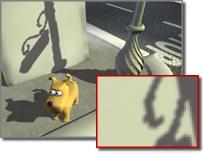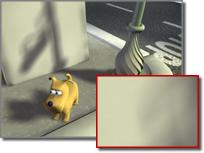
Glossary

Low sample range can cause jagged-edged shadows.

Higher sample range causes soft-edged shadows.
Sample Range affects the softness of the edge of shadow-mapped shadows. The sample range determines how much area within the shadow is averaged.
Small values reduce the area that is averaged, effectively bringing the edge of the shadow inward, producing sharper-edged shadows. Sharper edges can cause aliasing.
Large values extend the area that is averaged, effectively bringing the edge of the shadow outward, producing softer-edged shadows. Soft-edged shadows have more antialiasing. The effect is somewhat like the falloff of a soft-edged spotlight.
The default Sample Range value is 4. The Sample Range value can be any floating-point number from 0 to 20. Values of 2 to 5 are recommended. Values below 3 can produce coarse-edged shadows. You can reduce this effect by increasing the map size.
Values greater than 5 can produce streaking and moirΘ patterns. You can reduce this effect by increasing the map size or the Bias value.
Note: The gmax viewports don't display shadows, thus cannot show the effect of this setting. Your target render engine might or might not provide support for sample range.